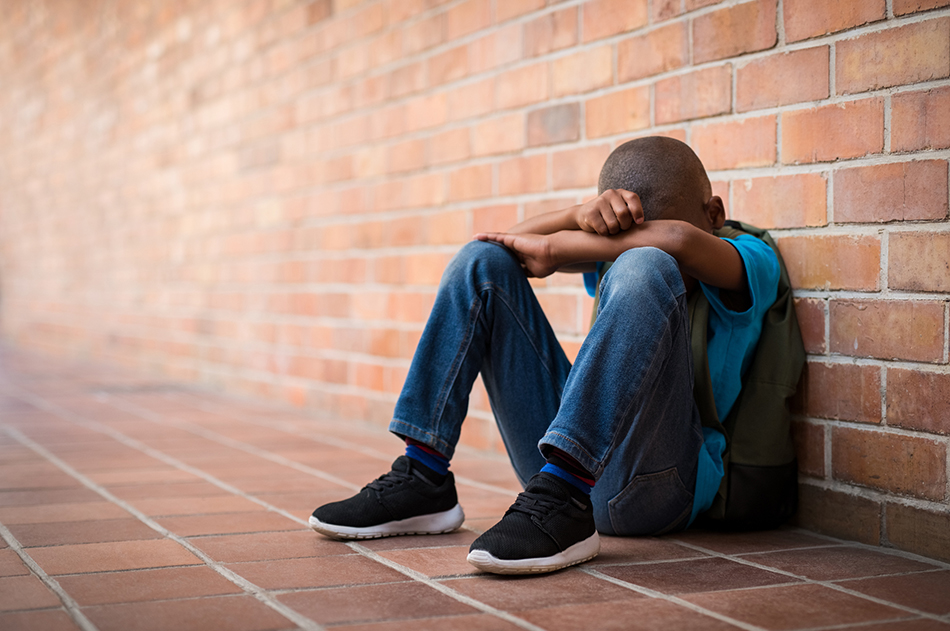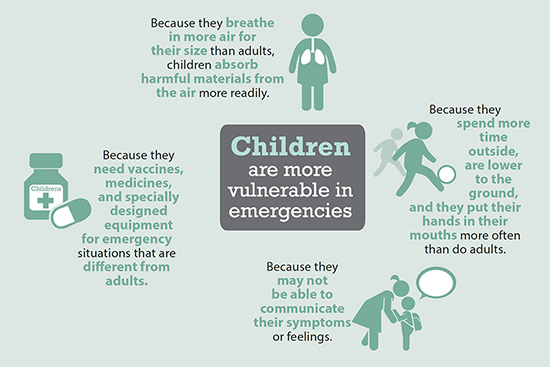Protecting Our Future: Emergency Preparedness and Children’s Mental Health
Posted on by
Among the many lessons learned during the 2017 Hurricane season, we recognized that addressing children’s mental and behavioral health needs is a major concern in hurricane-affected areas.
CDC’s At Risk Task Force (ARTF) was established in 2017 to ensure identification and prioritization of the mental and physical health needs of at-risk populations, including children. ARTF’s first Emergency Operations Center (EOC) activation was on Aug. 31, 2017, in response to Hurricane Harvey, the first of three consecutive hurricanes to hit the United States and its territories in a five-week period. ARTF’s mission was to address the needs of at-risk populations in affected areas throughout the response and recovery phases.
Early in the response, it became clear that the emotional impact of the storms and the mental health needs of people, particularly children, affected were a critical area of focus. ARTF worked closely with federal and non-government agencies to address these needs so that children and families had the best chance for recovery.
October 10 is World Mental Health Day. The theme this year is Young People and Mental Health in a Changing World. In light of this, we want to share our experiences to inform mental health interventions and improve outcomes for children after public health emergencies and natural disasters. First, let’s talk about what makes children more vulnerable in emergencies.
Why are children more vulnerable in emergencies?
Mental stress from a disaster can be harder on children.  Children are more vulnerable in emergencies because of their physical, developmental, behavioral, and emotional differences from adults. Children may have difficulty or may not be able to communicate symptoms or feelings. They may understand less about the situation and feel less able to control the events around them.
Children are more vulnerable in emergencies because of their physical, developmental, behavioral, and emotional differences from adults. Children may have difficulty or may not be able to communicate symptoms or feelings. They may understand less about the situation and feel less able to control the events around them.
The aftermath of an emergency or disaster is also difficult for children because they have less experience coping with difficult situations.
The emotional impact of an emergency depends on a child’s characteristics and experiences, the social and economic circumstances of the family and their community, and the availability of local resources. Other factors may influence the emotional impact on children, causing them to be more vulnerable in emergencies. These include children with mental, behavioral, or developmental disorders. Children who have experienced trauma in the past may also have more difficulty coping with a disaster.
What does the At Risk Task Force do for children’s mental health during a hurricane response?
During the 2017 hurricane season, the ARTF collaborated with federal and non-government partners to monitor behavioral health in affected areas and disseminate key messages and coping resources for children in schools and vulnerable populations in other contexts. ARTF coordinated a webinar for primary care physicians that focused on identification of common adjustment difficulties in children, provided strategies to promote effective coping skills in children and their parents, and explained the importance of self-care for professionals. The webinar was attended by more than 300 clinicians and other health care providers on Oct 26, 2017.
Public health professionals also play an important role in addressing short-term and enduring mental health needs of the population. Timely and accurate mental and behavioral health surveillance data, that includes specific information on children, could inform intervention efforts to improve developmental outcomes for children in the longer-term aftermath of disasters. It is important that mental health surveillance be incorporated into preparedness planning so that surveillance systems can be established or leveraged immediately when emergency response begins.
What are next steps for CDC?
Children’s mental health needs are a prominent concern in hurricane- affected areas. There is still a gap in real-time information on mental health needs to inform intervention efforts and improve child outcomes. CDC is working internally to enhance efforts to monitor health impacts during and after natural disasters, including integrating mental health into standard data collection.
affected areas. There is still a gap in real-time information on mental health needs to inform intervention efforts and improve child outcomes. CDC is working internally to enhance efforts to monitor health impacts during and after natural disasters, including integrating mental health into standard data collection.
CDC is also working with partners to integrate children’s mental health in preparedness planning. Following the 2017 hurricane season, CDC collaborated with the American Academy of Pediatrics to develop an activity book for children and families, Coping after a Disaster, that focuses on feelings children might have after a disaster and coping strategies that may help. This book is part of a series that follows Ready Wrigley, a dog who helps her family prepare for emergencies and their impacts.
CDC is now partnering with the National Hazard Center to develop mental and behavioral health training modules for researchers conducting field research immediately following an extreme event, such as a hurricane. These free, online trainings will provide background information on mental health in the context of disasters, as well as a list of mental health assessment tools used following a disaster for various vulnerable populations (e.g., children, older adults). The trainings and associated resources will address current research gaps in mental health, help to organize research in this area, and share best practices with researchers.
On Sept. 12, 2018, CDC activated the EOC to respond to Hurricane Florence, which made landfall off the coast of North Carolina on Sept. 13. The ARTF was quickly activated to address the needs of vulnerable populations. As the storm decreased in intensity, North Carolina began reporting increased emergency department visits related to stress and anxiety. Mental health concerns in children, similar to 2017, are expected to remain a prominent focus throughout the response and recovery phases. The ARTF continues to monitor the situation and support the mental and behavioral health needs of children and vulnerable populations in affected areas.
Additional Resources:
- Coping with a Disaster or Traumatic Event: https://emergency.cdc.gov/coping/index.asp
- Helping Children Cope with Emergencies: https://www.cdc.gov/childrenindisasters/helping-children-cope.html
- National Child Traumatic Stress Network: http://www.nctsn.org/
- American Academy of Pediatrics: Children & Disasters: aap.org/disasters
- American Psychological Association: Psychology Help Center: http://www.apa.org/helpcenter/
- Substance Abuse and Mental Health Services Administration: Disaster Distress Helpline: https://www.samhsa.gov/find-help/disaster-distress-helpline
4 comments on “Protecting Our Future: Emergency Preparedness and Children’s Mental Health”
Comments listed below are posted by individuals not associated with CDC, unless otherwise stated. These comments do not represent the official views of CDC, and CDC does not guarantee that any information posted by individuals on this site is correct, and disclaims any liability for any loss or damage resulting from reliance on any such information. Read more about our comment policy ».
This article is not only extremely informative, but also latent with excellent resources for children, parents, and mental health professionals. It is fantastic that children are becoming a focus after natural disasters as, like the article states, children are more vulnerable in emergencies. The At Risk Task Force is especially comforting to read about as the ARTF can provide valuable information to those who are capable of helping children in need. Specifically, the webinar conducted on October 26, 2017 is a wonderful start in educating mental and public health professionals about disaster relief – if this work is continued, it could aid health professionals to become more efficient in assisting at-risk youth. Moreover, the children’s activity books provided by the CDC is extremely useful for not only health professionals, but also parents and teachers who work closely with children.
This blog is such a great resource for parents to understand how natural disaster can impact children. When faced with natural disaster it can be hard to be think of the development of our children and how a natural disaster could impact them. The diagram provides a great snap shot on how children are more vulnerable in emergencies. Furthermore, the books mentioned are an invaluable resource to aid parents in the discussion of coping after a natural disaster.
This blog is more informative for all of us….
This article is really interesting to read, and this is coming from an RN who resides in Florida a notorious hurricane state. It is so important to think about matter such as these because, the affects from the hurricane can negatively impact an adult so how much more so a child? We need to ensure the children of such disasters are monitored and evaluated for mental health treatment. After reading this article and looking at the fact mental health care in children is so drastically underestimated in the United States and it is of great importance. That is why what the At Risk Task Force is doing for children that are affected by hurricanes causing mental distress is beneficial and hope this continues, especially since more inclement weather is effecting more states than ever before.